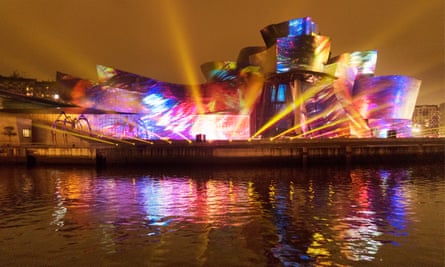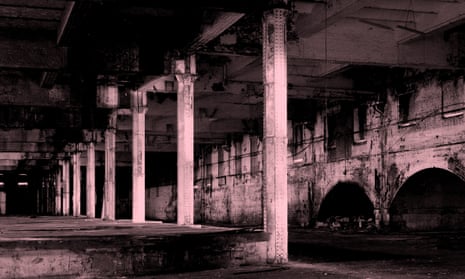Manchester, like most cities, is in constant flux. Cranes crowd the rapidly changing skyline as redevelopment reshapes the city centre. Not least at Mayfield; a vast 1910 goods depot and train station abandoned in the 1980s, £1.1bn will be spent over the next decade to turn this 24-acre site into a new neighbourhood.
The Guardian’s product and service reviews are independent and are in no way influenced by any advertiser or commercial initiative. We will earn a commission from the retailer if you buy something through an affiliate link. Learn more.
Where better during MIF to think about cities? How they are built, how they mould individuals and societies, what cities really mean. These are subjects that preoccupy London’s 59 Productions, whose Invisible Cities will transform Mayfield depot.
This forward-thinking creative company’s work – both as technical specialists and an independent production company – spans theatre, visual technologies and architecture, and is frequently in dialogue with the built environment. This is most visible through “projection-mapping” spectaculars at buildings such as the Sydney Opera House and Bilbao’s Guggenheim museum.
In collaboration with dance company Rambert and choreographer Sidi Larbi Cherkaoui, 59’s Invisible Cities will use dialogue, dance and cutting-edge visual effects to transport the audience to the 13th-century court of Kublai Khan, where – as per Italo Calvino’s 1974 novel of the same name – Venetian explorer Marco Polo is a close confidant of the Mongol emperor. Polo spends much of his time describing fantastical civilisations and cities to Khan, in an attempt to explain the outside world to this cosseted ruler. “Khan wants to understand what it means to control the world’s largest empire and millions of so-called citizens,” says 59’s founder-director, Leo Warner. “It’s about a man looking for truth, really.”
Calvino’s “very esoteric, very beautiful” book, adapted for this production by Lolita Chakrabarti, has obsessed Warner and 59’s head of architecture, Jenny Melville, for years, in which they wrestled with how they might stage it. “The challenge is making this apparently non-dramatic text speak compellingly to an audience,” says Warner. “We felt it was about evoking these cities, populating them and an emotionally resonant narrative. It wasn’t just about buildings, but how the populations of cities are shaped by the cities they inhabit and vice versa, and how that affects the world. It also had to be character-driven, so we decided to weave it around Kublai Khan and Marco Polo, and the evolution of their relationship.”

Being introduced to Mayfield depot, this vast industrial space of brick and iron, concrete and steel (previously used by MIF for warehouse raves and large-scale audiovisual art), was the key to finally unlocking Invisible Cities for 59. “The production directly responds to that specific, tactile, atmospheric space. It feels unchangeable and that was the provocation. How can we start in this very tangible space and out of that conjure extraordinary visions of places across time, realities and geographies?”
It is a mammoth task, logistically: “The venue has no infrastructure to support dancers, actors or lots of technology.” But to Warner that is the beauty of it. In a theatre, you expect “magic”. In monolithic Mayfield, that seems impossible. The audience will sit in four corners and, promises Warner, “it just gets weirder from there”.
Invisible Cities will utilise the lighting, visual and live film-making techniques that 59 has developed in such productions as the National Theatre’s War Horse and its own 2017 adaptation of Paul Auster’s City of Glass, but, says Warner, this is about more than using the building as a canvas. Mayfield will itself add “dramatic muscle” to the piece. 59 will make it melt away, echoing one of Calvino’s themes: that the solid – cities, societies, value systems – “can dissolve and become fluid”.
That insistence that “the form has to be narrative-serving, as part of one fabric” meant that, initially, 59 was “sniffy” about deploying its skills in projection-mapping at big public extravaganzas. By creating a 3D model of a structure, 59 is able to project filmed and animated content on to and into its every nook and cranny, with great precision and flexibility. Everywhere 59 has used it – from Edinburgh Castle to the United Nations’ New York HQ – the format has delivered more than mere eye-candy.

The turning point was agreeing to contribute to the 40th anniversary celebrations for the Sydney Opera House in 2013. Warner became increasingly fascinated by Danish architect Jørn Oberg Utzon’s remarkable feat of design and engineering, and, more surprisingly, the tortuous wrangling that had gone on between planners and politicians to get this radical building signed off. 59 Productions’ work in Sydney celebrated the building’s awesome geometry, while drawing out the human angles that influenced its conception: “In all our productions we look for a story. [In Sydney], that was the building’s genesis. We collaborated with the structure, we made it dance. That’s why we have in-house architects and video designers. It’s the conversation between the two media: concrete and light. That’s where the interesting stuff is. Not in using buildings as screens, but where the physical meets the ephemeral.”
That sense of humanity and fragility in all cities, of the instability of even the most ingenious of civilisations, is, perhaps, the theme of Invisible Cities: “One thing Calvino comes back to repeatedly is that cities aren’t really defined by the design process, but the events that occur in them or the intention of people living there, and that cities which strive after perfection end up creating infernal versions of themselves.”
Ultimately, hopes Warner: “Invisible Cities is an interrogation of humanity through the medium of cities.” That is a conversation pertinent across the globe, certainly not least in fast-changing Manchester.
Invisible Cities is at Mayfield, Fairfield St, Manchester M1 2QF, 2-6 July and 10-14 July
